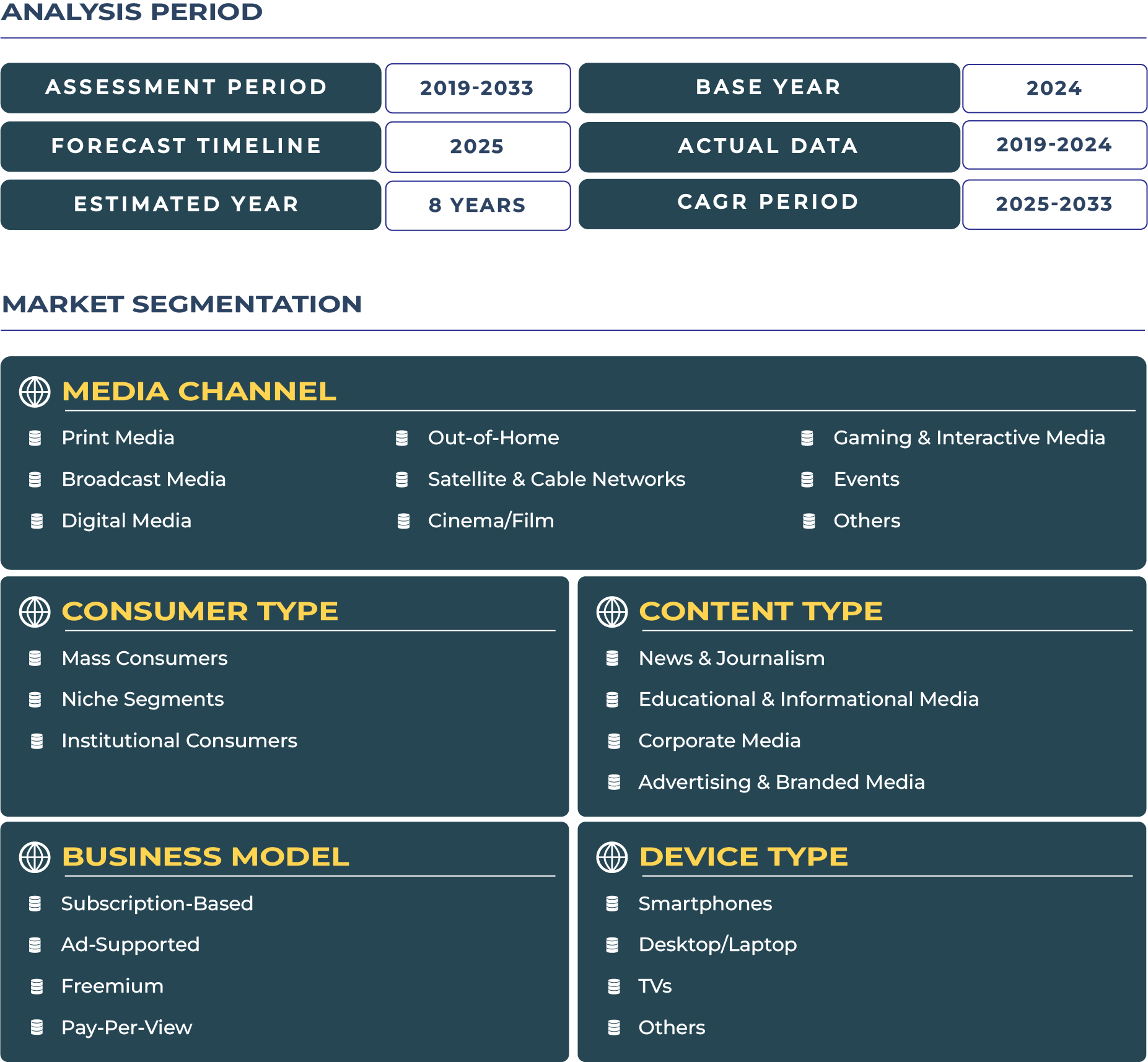Colombia Media Market Outlook
The Colombia media market is transitioning through a digitally driven evolution characterized by increased online consumption, expanding access to smart devices, and the localization of global media trends. According to DataCube Research, the Colombian media industry was valued at approximately US$ XX.4 billion in 2024, and is projected to reach US$ XX.9 billion by 2033, growing at a CAGR of X.3% between 2025 and 2033. This robust outlook is fueled by rapid digitization, urban internet expansion, and shifting audience preferences, especially among Colombia’s youthful and urbanized population. While traditional broadcast media like terrestrial TV and radio still maintain relevance in rural areas, urban consumers are increasingly migrating to on-demand, mobile-first formats. The Colombia media ecosystem is also seeing the rise of hybrid content models, blending entertainment, news, education, and commerce on digital platforms, further redefining how content is produced and monetized
Connectivity, Smart Devices, and Policy Drive Growth Momentum
One of the key accelerators of growth in the Colombia media sector is the rapid increase in internet penetration, which surpassed 76% by late 2024, according to OECD. With over 85% smartphone penetration in urban areas and rising demand for smart TVs, access to digital content has reached unprecedented levels. Platforms such as Claro Video, RCN, Caracol Play, and Netflix Colombia are leveraging this surge by investing in local content and mobile-friendly formats. Meanwhile, social media platforms like TikTok, YouTube, and Instagram have become central to Colombia’s content consumption habits
Government support is playing a significant role in bolstering this transformation. Programs led by Colombia’s Ministry of Information and Communication Technologies (MinTIC), such as “Vive Digital”, are expanding connectivity in remote areas and subsidizing access to broadband and digital devices. Additionally, media regulation policies are being restructured to encourage content innovation and protect local cultural expressions. The Colombian Film Development Fund is also investing in the digitalization of film and TV content, opening new monetization channels and strengthening national storytelling
Economic Environment Encourages Media Expansion
The strengthening macroeconomic environment is contributing positively to the Colombia media industry. As per the IMF, Colombia’s GDP per capita stood at US$ 7,400 in 2024, with a steady increase in disposable income supporting a rise in consumer spending on entertainment and digital services. Digital advertising expenditure now accounts for nearly 68% of total ad spend, showcasing a clear shift from traditional ad formats to performance-driven and programmatic models
Colombia is also becoming an emerging exporter of Spanish-language content. Colombian telenovelas, short-format dramas, and music videos have found strong demand across Latin America and in Hispanic markets in the U.S. and Spain. This growth in media exports, combined with increasing foreign co-productions and streaming partnerships, is enhancing the country’s visibility as a regional content production hub
Youthful Demographics and Shifting Media Habits Shape Demand
End user behavior in Colombia is a decisive factor in the media market’s growth trajectory. Colombians, on average, spend 7.1 hours daily across various media platforms, with a clear preference for digital over analog channels. Smartphone usage dominates media consumption, followed by smart TVs and desktop devices. The rise of OTT platforms, with a penetration rate of 42% in 2024, is being driven by a tech-savvy, youth-dominated population — nearly 45% of Colombians are under the age of 30
While younger audiences show a willingness to pay for premium services — with average monthly digital content spending at US$ 5.20 — there’s a notable split between urban and rural users, with the latter opting for ad-supported or bundled content offerings. The market is also witnessing growth in hybrid media, especially in areas like medtech adoption in Colombia, where content related to health, wellness, and telemedicine is being delivered via streaming and podcast platforms
Media Brands, Strategic Moves, and Cultural Alignment
The Colombia media ecosystem is populated by a dynamic mix of local champions and international platforms. Caracol Televisión and RCN Televisión remain dominant local players, both expanding into digital streaming and mobile apps to cater to younger audiences. International giants such as Netflix, Amazon Prime Video, and Spotify have tailored their content offerings with Colombian originals and regional partnerships. In 2024, Netflix premiered “Goles en la Sombra”, a Colombian mini-series that gained regional success and increased subscription numbers in Bogotá and Medellín
Strategically, media companies are focusing on content localization, AI-driven recommendations, and multi-platform bundling. In March 2024, Claro Colombia introduced a new entertainment package integrating live TV, streaming, and gaming — a model increasingly favored by Gen Z users. Meanwhile, YouTube Colombia’s Creator Accelerator Program has empowered local influencers to monetize niche content, including indigenous culture, music, and social issues, reinforcing content diversity
Cultural preferences remain central to content strategy. Spanish is the dominant language, but there is growing demand for indigenous-language subtitles and content reflecting Afro-Colombian and indigenous identities. Platforms that successfully blend mainstream appeal with local relevance are seeing stronger engagement and retention
Colombia Media Sector Poised for a Digital and Cultural Renaissance
The Colombia media market is on the cusp of a digital and cultural renaissance. With a solid economic foundation, rapidly improving infrastructure, and a youthful population hungry for personalized content, the Colombia media sector is transforming from traditional broadcasting to an interconnected, consumer-centric digital powerhouse. As content creators and media platforms continue to embrace innovation, diversity, and strategic collaboration, Colombia is well-positioned to become a leading force in the Latin American media landscape by 2033
Author: Joseph Gomes Y (Head – Media and Entertainment)
*Research Methodology: This report is based on DataCube’s proprietary 3-stage forecasting model, combining primary research, secondary data triangulation, and expert validation. [Learn more]







